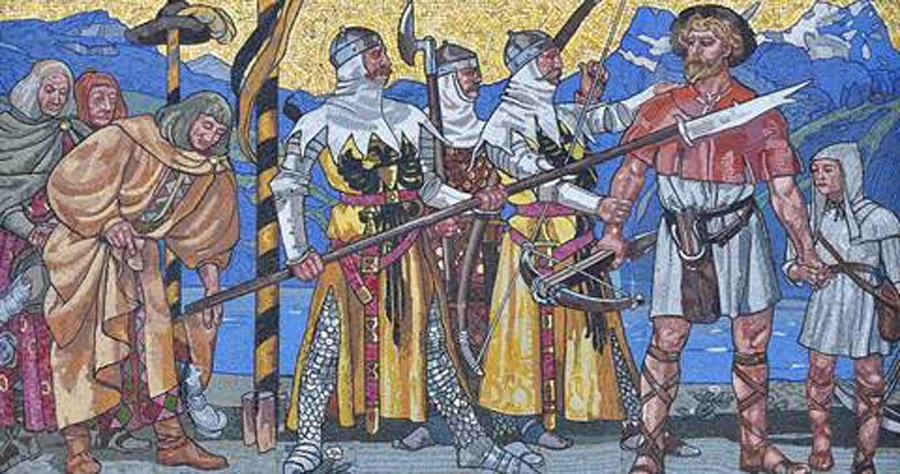William Tell is a familiar name to many, but perhaps only for a couple of reasons. Most will recall the story of shooting an apple from the head of a child, and if pressed will also mention the William Tell Overture popularized as the theme tune of the US television series The Lone Ranger.
But beyond that, it seems that little is memorable to modern audiences about this Swiss folk hero. Who was the real man behind the legends? Was he real at all?
The Legendary William Tell
Tell was an accomplished marksman with the crossbow, according to tradition, who assassinated Albrecht Gessler, a tyrannical local representative of the Austrian dukes of the House of Habsburg based in Altdorf. Tell’s disobedience and tyranny incited the inhabitants to revolt and form a coalition against the foreign rulers, creating what would become the Swiss Confederacy.
Already there are clear parallels with another famous folk hero, this one English. Robin Hood was also a famous marksman, and also fought against a villainous representative of a tyrannical ruling nobility, in his case the Sherriff of Nottingham. Are these simply common legends, shared amongst the poor, or are there truths to either of these tales?
The narrative is said to have begun in the early 14th century (traditionally 1307, during the reign of Albert of Habsburg), although the first documented accounts of it originate from the late 15th century when the Swiss Confederacy was acquiring military and political power. Tell, for all his dubious authenticity, is a major character in Swiss national history.
- England’s Great Outlaw, Robin Hood: Real or Legend?
- The Legend of Miloš Obilić: Did He Assassinate a Sultan?
He was seen as a symbolic figurehead during the formative period of modern Switzerland in the nineteenth century, known as the “Restoration and Regeneration” period. In the wider history of 18th and 19th-century Europe he is also seen as a symbol of resistance to aristocratic rule. The 1848 Revolution against the House of Habsburg, still ruling Austria five centuries later, invoked the resistance of Tell.
What Did He Do?
The White Book of Sarnen, written in 1474 almost 200 years after Tell was supposed to have lived, contains the first mention of Tell, although he is not named. The text mentions a legendary oath to the Swiss Confederacy named the “Rütli Oath” which Tell took and which, with the murder of Albrecht Gessler, sparked a rebellion known as the Burgenbruch Insurrection.

The Tellenlied, a ballad written in the 1470, contains another early story of Tell. The song starts with the Tell narrative, which it portrays as the origin of the Confederacy and Tell as the first confederate. Here the story is given more detail: Tell was forced to shoot an apple from the head of a child by Gessler, whom he then kills with a second arrow before escaping.
Strangely, this text omits the actual death of Gessler although it notes that Tell prepares the arrow to kill him. The text then goes on to list the Confederacy’s cantons, claiming that it was enlarged with present events during the Burgundy Wars, which ended with Charles the Bold’s death in 1477.
An extended version of the legend is presented by Aegidius Tschudi, who wrote a hundred years later still, around 1570. Tschudi adds more detail to the White Book account, probably (as elsewhere) of his own invention. Tell’s first name being “Wilhelm” (William), his origins in Burglen, the date of the apple shot and the story of his death in 1354 are among the extra details.
This is the version, later fabrications and all, that became popular. William Tell here is a mountain climber and a skilled crossbow shooter. The House of Habsburg monarchs of Austria sought to govern the Swiss canton of Uri during the time, and Tell was characterized one of Werner Stauffacher’s conspirators, who promised to resist Habsburg dominion.
Albrecht Gessler was the Austrian Vogt (overseer) of Altdorf, Switzerland, who had just been appointed. He erected a pole beneath the village linden tree, hung his hat atop it, and insisted that everyone in the hamlet bow before it. When Tell resisted, he forced him to take the famous apple shot. Tell succeeded, was imprisoned, escaped, killed Gessler and led the rebellion to free Switzerland.
A Real History, and a Real Man?
The story may perhaps seem too good to be true, and in truth, the story of William Tell was considered dubious well before modern assessments. An advisor to the Habsburg Emperor writing in the early 17th century considered the entire history to be a fabrication.

The fact that, although the Swiss insurrection is well documented, there is no contemporary reference to Tell, further casts doubt on the narrative. Parts of the legend, such as the impossible shot to hit an apple, have earlier sources and appear in other, generally Norse, legendary traditions.
Here then, it would seem that we have a later legend, a patriotic folk hero inserted into the narrative of Swiss resistance against the dominant Habsburg rulers to provide a figurehead. Further, by extolling the virtues of an outdoors man, and by being a commoner, William Tell provided to the story the suggestion that this revolt was not merely a dynastic struggle amongst the nobility but a genuine uprising among the people.
Tell provided the common touch. And, whenever in later years a hero was needed to stir up Swiss patriotism, he was invoked again details were added, and the tale grew with the telling.
Was he a real person? Possibly, but to insist on this is to miss the point. Whether he existed or not, the William Tell we know of today was certainly a later fabrication.
Top Image: Is there any truth to the story of William Tell? Source: Mario Breda / Adobe Stock.
By Bipin Dimri